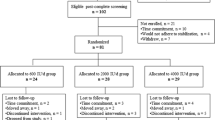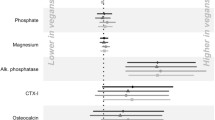Abstract:
Vitamin D status is known to be an important determinant of bone mineral density (BMD). There is a significant seasonal variation in serum vitamin D, and some studies have reported an associated seasonal variation in BMD. The present study was devised to investigate whether a seasonal variation in BMD could be detected in healthy normal subjects, along with associated variations in serum parathyroid hormone (PTH), intestinal calcium absorption and biochemical markers of bone turnover. A second aim was to investigate whether, if such variations were identified, they could be suppressed by vitamin D supplementation. The subjects were 70 healthy female volunteers (mean age 47.2 years, range 24–70 years) recruited into a double-masked crossover study and followed over 2 years. During the first year 35 subjects received a daily oral supplement containing 800 IU (20 mg) cholecalciferol (group 1) and 35 subjects received a placebo preparation (group 2). During the second year the treatment each group received was reversed. Lumbar spine (L1–L4), left proximal femur and total body BMD were measured by DXA at 3-month intervals. Serum 25-hydroxyvitamin D (25-OHD), serum PTH, bone markers (bone-specific ALP (BSAP) and urinary crosslinks (DYPD/creatinine)) and calcium absorption were also measured at each visit. Cholecalciferol treatment increased serum 25-OHD by 25.4 nmol/l (p <0.001), while a reciprocal decrease in serum PTH of 6.6 ng/l (p = 0.011) was seen in subjects in the lowest quartile of baseline serum 25-OHD. The treatment had no significant effect on spine, femur or total body BMD, calcium absorption or bone markers. When Fourier analysis was used to analyze the data for seasonal effect (defined as twice the amplitude of the 1-year period variation) a highly significant effect for 25-OHD of 18 nmol/l (p <0.001) was found. However, no effect was found for BMD, PTH, calcium absorption or bone markers. The analysis set a 95% confidence limit to the seasonal effect of less than 0.6% for spine, total hip and total body BMD. It was concluded that in the population of healthy women studied there was no evidence of seasonal variation in spine, femur or total body BMD, serum PTH, calcium absorption or bone markers. Vitamin D supplementation was found to have no effect on BMD.
Similar content being viewed by others
Author information
Authors and Affiliations
Additional information
Received: 7 July 2000 / Accepted: 14 November 2000
Rights and permissions
About this article
Cite this article
Patel, R., Collins, D., Bullock, S. et al. The Effect of Season and Vitamin D Supplementation on Bone Mineral Density in Healthy Women: A Double-Masked Crossover Study . Osteoporos Int 12, 319–325 (2001). https://doi.org/10.1007/s001980170122
Published:
Issue Date:
DOI: https://doi.org/10.1007/s001980170122




